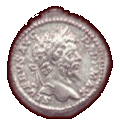
This
is based on history and today’s metal science. Surgical
stainless steel (316L) and titanium are near the bottom of the
Galvanic Corrosion Table (following this topic). These metals
are a very new developments with respect to history. Bronze,
silver, gold and sheet metals have been excavated from sites
thousands of years old. The Gateway Arch in Saint Louis has an
estimated life span of over 500 years. It’s made using
304 stainless and is subject to severe stress. Copper Roman coins,
a very soft metal, are still readable after thousands of years
underground. Immortal Memories™ Tributes, made using the
most durable metals developed by man to date, will be here and
legible for thousands of
years.
Surgical
stainless steel is a variation of
steel consisting of an alloy of chromium (12-20%), molybdenum
(0.2-3%), and sometimes nickel (8-12%). The chromium gives
the metal its sheen, scratch-resistance and corrosion resistance.
The molybdenum gives corrosion-resistance, and helps maintaining
a cutting edge.
Grade
316 stainless steel has excellent corrosion resistance in a wide
range of media. Better corrosion resistance than grades 302 and
304; resists sodium and calcium brines; hypochlorite solutions,
phosphoric acid; and the sulfite liquors and sulfurous acids.
 NISHIYAMA
Yoichi
NISHIYAMA
Yoichi
Professor
Department of Literature
Nara University
“Metal
relics discovered at archaeological sites in Japan can be divided
roughly into three categories: those made of iron, bronze, and
those of gold or silver. Iron relics include swords, arrowheads,
and armor; bronze relics include mirrors, coins and dotaku (bronze
bell-shaped vessels); gold and silver relics are mostly jewelry,
such as earrings, rings, and beads. Tin fittings have also been
excavated, but they are generally rare. A considerable number
of metal artifacts were discovered in archaeological sites dating
after the Yayoi period (ca. 350 BC to 4th century AD). In particular
many metal artifacts, including swords and bronze mirrors, have
been discovered in kofun, which are burial mounds from the Kofun
period (ca. 4th to 7th century AD).
Iron
and bronze relics are especially fragile, as they undergo the
process of oxidation while buried.
Their deterioration continues rapidly after excavation. Therefore,
iron and bronze relics must undergo scientific treatment for
their preservation.”
*********************************
The
oldest archaeological site in South America containing metal
artifacts is located in coastal Peru; the artifacts are dated
to between 1400 B.C. and 1100 B.C. From 200 B.C. to A.D. 1000,
sheet metal working was pervasive throughout
the Andes.
*********************************
 The
Greeks and Romans minted coins hundreds of years before the time
of Christ. The most common ancient coins are Roman coins minted
in the third and fourth centuries AD (200 AD to 400 AD), so most
ancient coins are 1600 years old or older, and many are over
2000 years old. The very earliest coins were struck about 600
BC.
The
Greeks and Romans minted coins hundreds of years before the time
of Christ. The most common ancient coins are Roman coins minted
in the third and fourth centuries AD (200 AD to 400 AD), so most
ancient coins are 1600 years old or older, and many are over
2000 years old. The very earliest coins were struck about 600
BC.
Protective
Coatings:
The metal coatings (oxide or PVD) are not the
problem. As mentioned on our Coatings page,
the oxide or PVD metal coatings have a propensity to scratch. In
an outdoor environment where where wind, dirt, and potential vandals
lurk, a protective coating is necessary. All memorial producers
I've reviewed only guarantee their coatings for a limited duration.
We would have to do the same for our FPU coating, which is one
of the finest coatings in the world. However, it still has an organic
base. The ultimate answer is a thick-film synthetic diamond. To
date (June 15, 2013) it is not available. We are constantly looking
for new possibilities. We are now working with a company in Ohio
that may have a new option.